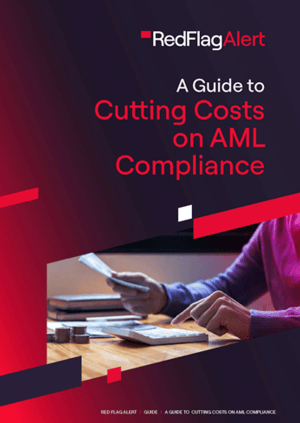Each new Anti-Money Laundering Directive introduces changes that affect regulated businesses.
The new AML 6 directive broadens the scope of money laundering offences and introduces new ‘predicate’ offences for companies that operate in the EU.
In light of this, AML-regulated companies have had to implement more stringent checks or face serious consequences.
However, 6AMLD has also brought much-needed clarity on the definition and identification of money laundering and predicate offences.
In this article we’ll cover everything you need to know about 6AMLD, including:
- What 6AMLD is.
- When countries began to implement 6AMLD.
- The significant regulatory changes 6AMLD has brought.
- The positive and negative impacts 6AMLD has had on businesses.
- Key compliance considerations for AML-regulated businesses.
- We’ll provide some background into previous AML directives and look at the future of AML directives.
What Are AML Directives?
Since then, AML regulations have expanded to include other financial institutions, professional services and emerging technologies, such as cryptocurrencies.
Current AML directives have also broadened in focus to include money laundering, terrorist financing, corruption and other activities not previously defined by earlier regulations.
Here are the most significant changes that each directive has addressed since 1AMLD:
The 2nd Anti-Money Laundering Directive (2AMLD)
Targeted activities related to corruption, and more financial services became subject to AML regulations.
The 3rd Anti-Money Laundering Directive (3AMLD)
Extended the scope of AML to the gaming industry and professional services like lawyers, real estate agents and accountants. The directive also highlighted the funding of terrorism and introduced the requirements of Customer Due Diligence (CDD) and Suspicious Activity Reporting (SAR).
The 4th Anti-Money Laundering Directive (4AMLD)
Introduced a risk-based approach, which prescribed that businesses allocate resources relative to perceived risk. It also introduced Enhanced Due Diligence (EDD) requirements for high-risk clients and required firms to document Ultimate Beneficial Owners (UBOs).
The 5th Anti-Money Laundering Directive (5AMLD)
Extended the previous UBO requirements to create beneficial ownership registers and included virtual assets and exchanges under AML regulations. The directive’s goal was to enhance access to intelligence for the EU’s Financial Intelligence Units (FIUs).
What Was the 5th AML Directive?
The 5th AML Directive was adopted into national law by 10 January 2020, partly in response to recent terror attacks in Britain, Belgium and France.
5AMLD didn’t modify the penalties for regulatory breaches. However, it did widen the scope of multiple regulations. Here are the policy changes it enacted:
1. Regulation of virtual assets
Due to their anonymous nature, money launderers and criminals favour virtual assets and currencies. To combat this, the EU Commission now requires that cryptocurrency exchanges register with the relevant governing bodies, conduct AML checks and file SARs.
The directive also required FIUs to keep records of individuals who purchase virtual assets and banned the use of anonymous safe-deposit boxes.
Other affected parties include:
- Cryptoasset ATMs
- Custodian wallet providers
- Peer-to-peer exchanges
- Issuers of new coins
2. Beneficial ownership registries
5AMLD expanded previous UBO directives. It required EU states to maintain national UBO registries. These registries are accessible to the general public and do not require demonstrable legitimate interest to gain access.
However, any governing bodies or professional sector service providers (i.e., banks, accountants, stockbrokers, etc.) must demonstrate a legitimate interest to gain access to a national UBO register.
3. Clarification around Politically Exposed Persons (PEPs)
5AMLD required member states to create a national PEP list that details the titles, roles or functions of politically exposed people for monitoring. The EU commission then consolidated these lists and published the data anonymously to keep identities private.
4. Extended the scope of high-value goods regulation
The EU expanded the scope of AML regulation on high-value goods to include:
- Art
- Tobacco
- Arms
- Precious metals
- Oil
- Historical, cultural and archaeological artefacts
5. Due diligence measures for high-risk third countries
High-risk third countries are states outside the EU that do not have solid AML regulations in place.
The directive stipulated that any client based in one of these countries will be subject to increased due diligence measures such as:
- Source of Wealth investigations
- Beneficial ownership checks
- Additional background checks
On top of this, 5AMLD empowered EU states to prevent financial services firms from opening new offices within these high-risk third countries.
6. Lowered prepaid card limits
5AMLD also redefined anonymous prepaid card limits within EU states. These were lowered from €250 to €150, with cards purchased online being capped at €50. Additionally, only prepaid cards issued within the EU or another low-risk country were permitted for use.
What Is the 6th AML Directive?
The 6th AML Directive is the most recent update to the EU’s anti-money laundering directives. Its primary aim is to make identifying money laundering crimes and perpetrators easier for businesses and law enforcement.
The directive broadened the scope of the 5th AML directive to include:
- Financial and professional services firms who fail to prevent money laundering
- Money launderers themselves
- Individuals who are complicit in money laundering but aren’t the ultimate beneficiary
The directive encourages enforcement agencies in EU states to collaborate on crimes occurring across multiple jurisdictions and enhances cross-border cooperation.
When was the 6th AML Directive Implemented?
EU states were expected to implement 6AMLD into national legislation by 3 December 2020, while firms had until 3 June 2021 to comply.
By this date, firms subject to AML regulations needed to have:
- Updated any relevant AML processes, policies and procedures
- Implemented training and education for staff
- Carried out a business risk assessment
Following Brexit, the UK isn’t formally required to adopt AMLD6.
The British government does not plan on implementing AMLD6. They contend that domestic anti-money laundering legislation is already compliant with the new directive.
Furthermore, they argue that existing UK regulations relating to offences and sentences are on par with those proposed in 6AMLD.
However, any UK firms that operate within the EU or trade with businesses there must implement 6AMLD measures regardless of the government's stance.
What Are the Main Changes in the 6th Anti-Money Laundering Directive?
The 6th Anti-Money Laundering Directive aims to strengthen money laundering legislation and clarify offences.
In particular, 6AMLD:
- Widens the regulatory scope of money laundering offences.
- Clarifies the definitions of offences and perpetrators.
- Implements stricter penalties for crimes.
- Seeks to promote cross-border cooperation further and simplify dual criminality within EU states.
Consistent Predicate Offence Definitions
Predicate offences are secondary offences, such as counterfeiting currency, which lead to more significant crimes like terrorist financing.
6AMLD narrows criminal activity down to 22 predicate offences and defines these offences for all EU states to avoid confusion and fragmentations.
Here are the current definitions of offences as set out by 6AMLD :
- Participating in an organised crime group or racketeering
- Tax crime relating to both direct and indirect taxes
- Illicit trafficking in narcotics and psychotropic substance
- Human trafficking and migrant smuggling
- Insider trading and market manipulation
- Murder and grievous bodily harm (GBH)
- Counterfeiting and piracy of products
- Kidnapping and hostage-taking
- Terrorism
- Cybercrime
- Piracy
- Forgery
- Extortion
- Smuggling
- Fraud
- Corruption
- Robbery and theft
- Sexual exploitation
- Counterfeiting currency
- Environment al crime
- Illegal arms trafficking
- Trafficking in stolen goods
Criminal Liability Extensions
A significant change for AML-regulated firms with the recent directive is the extension of criminal liability to legal persons or any legal entity under EU law.
This means that firms operating in any EU member state can be liable for failing to prevent money laundering activities—even if authorities cannot identify the criminal activity in question.
Penalties for these offences vary and can include:
- Temporary or permanent bans on the practice of commercial activities
- Judicial supervision
- Temporary or permanent closures of the establishment where a crime took place
Tougher Punishments for Breaches
6AMLD introduces harsher penalties for people convicted of money laundering offences. The maximum jail sentence is now four years rather than one year.
Authorities also can freeze or confiscate the proceeds of money laundering and any assets used to commit the offence.
Dual Criminality and the Cooperation of EU Members
Criminals and money launderers often operate across borders. As a result, the EU seeks to promote practical cross-border cooperation and communication to prosecute offenders.
However, a significant problem with dual criminality cases is deciding where criminal proceedings should occur.
The new directive provides guidelines to assist law enforcement in determining a suitable location for prosecution. Law enforcement agencies consider:
- The location where money laundering offences happened.
- The nationality or residency of the perpetrator.
- The victim(s) country of origin.
- Where the offender was arrested or identified.
Money Laundering Offence Expansion
In a bid to consolidate AML legislation and implementation across member states, the directive provides concrete definitions of what constitutes a “money laundering offence.”
AML legislation in the EU has broadened to include accomplices and other secondary individuals. Offences that now warrant criminal prosecution when carried out intentionally include:
- Concealing sources of illicit gains
- Aiding and abetting money laundering activities
- Inciting or attempting money laundering
- Converting or transferring assets gained through criminal activity
- Acquiring, possessing or using property that has been illegally gained
The Impact of the AML 6D on Businesses
The new AMLD 6 regulations have had positive and negative impacts on businesses that operate in the EU.
Positive impacts:
- More clarity on money laundering offences: Clear definitions of money laundering and predicate offences make identifying money laundering activities easier for law enforcement.
- Increased protection of consumers and other businesses: New money laundering security measures protect consumers and prevent otherwise compliant firms from falling victim to money laundering.
- Dealing with dual criminality: The new directive requires that businesses work with law enforcement agencies. Additionally, AML6D seeks to enhance cross-border law enforcement efforts.
Negative impacts:
- Costs for businesses have increased: Additional compliance processes mean higher compliance costs.
- Higher risks for AML-regulated companies: Businesses now have increased liability and can be punished for failing to prevent money laundering or predicate offences.
- Severe penalties for non-compliance and offences: The consequences of non-compliance in the EU have increased and can lead to temporary bans or permanent closures of businesses.
- Increased compliance requirements for global firms: International businesses, including UK firms that operate in the EU, must comply with the additional regulations 6AMLD imposes.
6AMLD Key Compliance Considerations
The EU’s AML Directive 6 presented significant changes which will have a lasting effect on AML-regulated organisations.
Business leaders should be aware of the following points:
1. The new money laundering and predicate offence definitions
Since these definitions will be consistent across all EU states, businesses must educate their employees on the revised regulations around money laundering and identifying prohibited activities.
2. Criminal liability extensions
Since businesses can now be held liable for money laundering offences, the employees responsible for AML management must update their knowledge of regulations, responsibilities, and procedures.
3. Scope extensions
Under AMLD 6, more offences fall under the category of money laundering. Employees and managers must familiarise themselves with what constitutes money laundering and what processes they need to have to meet regulations. This will help them remain compliant and reduce exposure to prosecution.
How to Implement AMLD6 in Your Company
It’s essential that businesses understand the requirements of AMLD6, but companies will still
need a strategy to meet their compliance goals.
All businesses that are implementing 6AMLD should take the following steps:
1. Transpose the new legislation into the company’s documentation
Organisations must have easy-to-reference definitions and legislation for management and compliance teams to refer to.
On top of this, the compliance manager should incorporate the new additions into the business’s standard operating compliance procedures.
2. Perform risk assessments
Compliance teams should evaluate how current infrastructure and technology solutions can assist their organisation’s compliance goals.
In particular, businesses will need to modify:
- Due diligence procedures to accurately identify money laundering based on the new definitions and scope expansions of 6AMLD.
- How they detect cybercrime and environmental crime—the two new predicate offences.
- Their processes for sharing information securely in the case of cross-border crimes.
After this, they should re-assess current clients against the new risk criteria by performing an enterprise-wide risk assessment. This assessment will gauge business, geographical and client risks.
3. Train your compliance team
Your compliance team is your business’s main line of defence against money laundering. That’s why AML employees must know how 6AMLD affects their responsibilities.
Management should review and revise training materials and update compliance personnel with new regulations, guidelines, and procedures.
4. Assess your technology needs
As AMLD6 shows, AML regulations are continually being updated and refined. For this reason, it's a good idea to assess the effectiveness of current technology solutions.
Your AML technology should be able to:
- Accurately and efficiently analyse AML data
- Easily conduct full-scale AML checks
- Onboard new clients quickly
- Know the risk status of its clients in real-time
- Easily adapt to new regulatory updates
If it doesn’t allow your business to do this, then find a technology solution to replace or complement your current setup.
Future Developments for AML Directives
EU Anti-Money Laundering Directives rely on member states to pass legislation. This can cause delays, confusion and inconsistencies in applying the law.
Work still needs to be done to improve regulatory effectiveness. However, the EU still hasn’t reached a solution.
One potential pathway to resolving these issues is a 7th Anti-Money Laundering Directive. Another is formulating a set of AML laws created by the EU Commission for member states.
A third possible route is to create a set of EU-wide regulations. This would mean that AML regulations become law for all EU states, rather than waiting for members to pass them.
Whichever path they decide, the EU Commission’s goals are to:
1. Effectively implement existing AML regulations
Since member states are responsible for transposing EU directives into their national law, implementation is fragmented. As a result, the EU Commission has begun to enforce infringement proceedings against lagging countries.
The European Banking Authority (EBA) has also been given the authority to spearhead AML efforts among EU financial service providers.
2. Move towards a single EU-wide AML rulebook
The current AML directives rely on member countries to implement national legislation, which has resulted in regulatory fragmentation.
The EU believes this increases costs and complexity for AML-regulated firms and results in poor cooperation and cross-border prosecution.
Instead, the EU aims to establish direct legislation that addresses:
- Who falls under AML regulations
- What the customer due diligence requirements should be
- Internal controls
- Firm reporting obligations
- How to handle beneficial ownership
- Registers (UBO, PEP, etc.) and central bank account mechanisms
- Dealing with technological innovations
- Remote customer identification and verification
3. Have EU-level AML supervision
Due to the different values and views of EU states, each has a different priority level regarding AML regulation. Consequently, the EU Commission believes this causes systemic weakness and reduces the effectiveness of AML directives.
The EU is looking to implement an EU-wide supervisory system to combat this once all member states have implemented current AML directives into national law. The current plan is to have the supervisory agency oversee and instruct national authorities.
4. Create consistent mechanisms for FIUs
Since SARs are guided by national legislation and FIUs, rules differ between EU member states. The EU sees these factors as hurdles to efficient cross-border investigations.
The proposed solution is to implement an FIU coordination and support mechanism at a regional level to support member states in cross-border investigations.
5. Implement EU-level criminal prosecution
Each state implements variations on the EU’s AML directive. This creates a need for an EU-level governing body to coordinate investigations and prosecutions. The proposed solution is the European Financial and Economic Crime Centre, an EU-wide financial crime body.
On top of this, the Anti-Money Laundering Operational Network (AMON) is being developed to provide a bridge between law enforcement and the European Public Prosecutor’s Office.
6. Lead international AML regulation and policy
While the FATF (Financial Action Task Force) currently proposes international recommendations for AML policy, the EU is looking to lead and be an influential part of global regulatory developments.
How Red Flag Alert Can Help Your Business Stay Compliant
Complex AML changes continue to be difficult for both countries and firms to implement. It’s therefore wise to implement a technological solution to ensure compliance.
With Red Flag Alert’s AML checks compliance solution, your business will be ready for any regulatory changes.
Red Flag Alert’s AML solution can help:
- Keep your business safe from prosecution with complete risk checks, including EDD.
- Analyse clients in real-time to avoid unforeseen risks that emerge after regulatory changes.
- Create a secure audit trail for effective cross-border investigations.
To learn more about how Red Flag Alert can help your business stay compliant through 6AMLD and beyond, contact our team.





